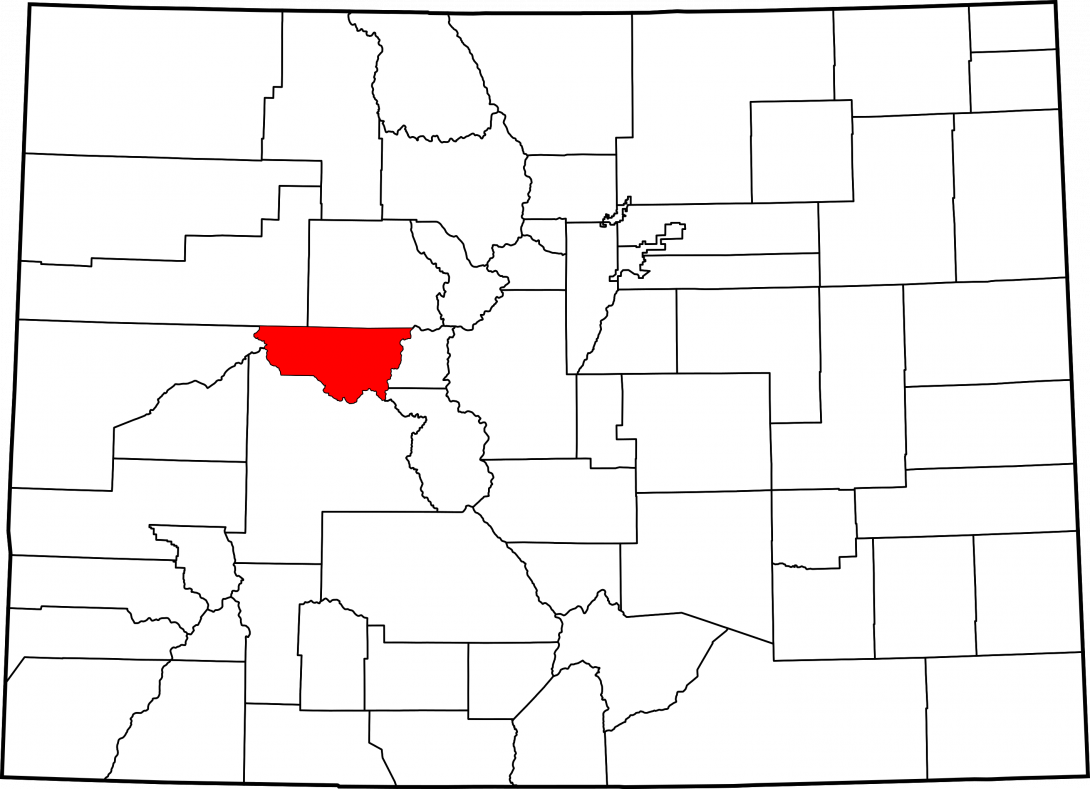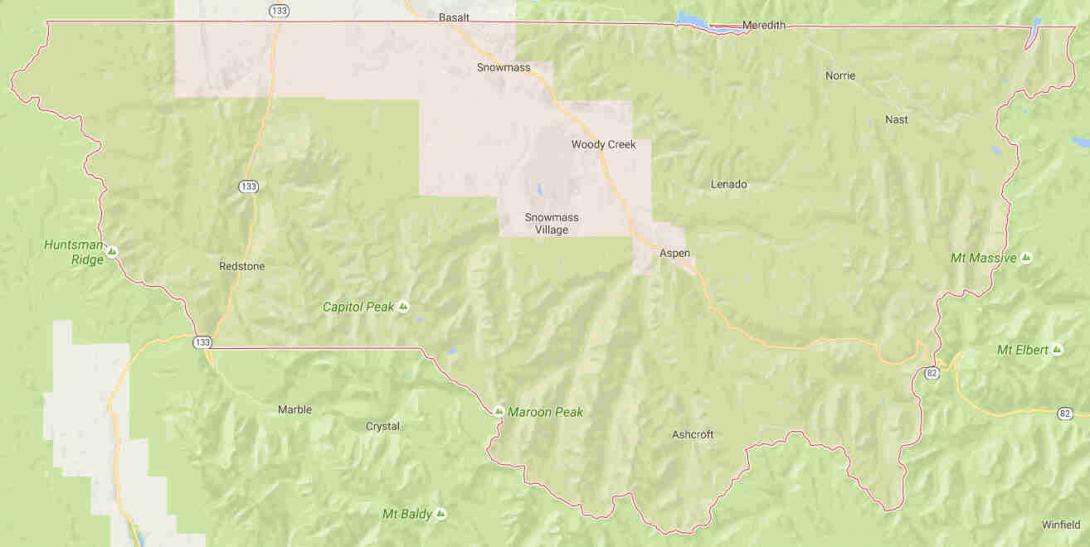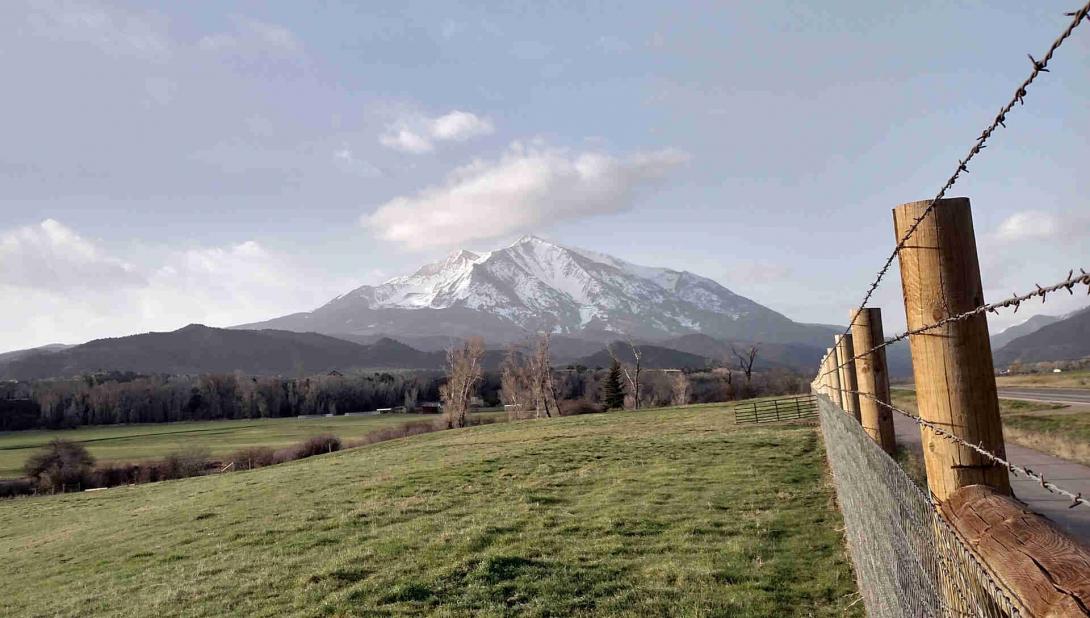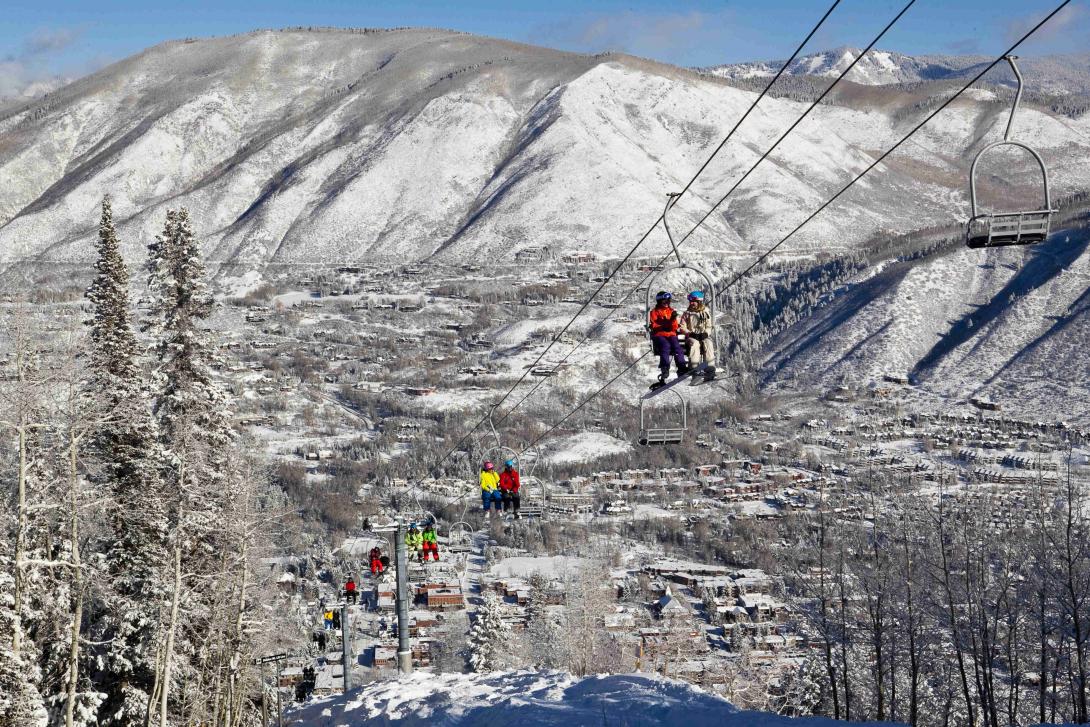Pitkin County
Full Article
Pitkin County, named after former Colorado governor Frederick Pitkin, is located in west-central Colorado, spanning 973 square miles of mountains and the Roaring Fork River valley. It is bordered by Garfield and Eagle Counties to the north, Lake and Chaffee Counties to the east, Gunnison County to the south, and Mesa County to the west. The county has a population of 17,148 and is one of the most popular tourist destinations in the Rocky Mountains.
Pitkin County is home to six of Colorado’s Fourteeners, mountains standing 14,000 feet or higher: Pyramid Peak (14,025), Snowmass Peak (14,099), Capitol Peak (14,137), Castle Peak (14,279), and the Maroon Bells—Maroon Peak (14,163) and North Maroon Peak (14,019). The White River National Forest occupies most of the southern portion of Pitkin County. Aspen, the county seat, was founded during a silver boom during the 1870s and is now a popular ski destination, as well as the cultural hub of the Western Slope.
Native Americans
From about the mid-sixteenth century until the late nineteenth century, the Pitkin County area was inhabited by a band of Ute Indians called the Parianuche, or “elk people.” The Utes hunted elk, deer, and other mountain game. They also gathered a wide assortment of roots, including the versatile yucca root, and wild berries. In the summer, they followed game into the high country, to places like the Roaring Fork and Crystal River valleys. They spent winters near the present site of Glenwood Springs.
Nonnative people did not come to the Pitkin County area until several surveying expeditions between 1867 and 1878 mapped out the land and noted possible mineral deposits. Meant to keep the Utes away from rich gold strikes along the Front Range, the Treaty of 1868 granted the Native Americans a large territory west of the Continental Divide. The reservation's eastern border lay about ten miles west of present-day Aspen.
White Settlement and Conflict
Prospectors followed the surveyors to the Pitkin County area in the 1870s, but found that the Utes were unwilling to let them stay. In 1872, for example, the Ute leader Colorow and a group of warriors burned a cabin in the Crystal River valley and forced the prospectors there to flee. In the summer of 1879, H.B. Gillespie and twenty-three other prospectors entered the Roaring Fork Valley and began staking silver claims. But after the Meeker Incident at the White River Indian Agency in September, Colorado governor Frederick Pitkin grew anxious about any white settlement on the Western Slope; he urged the miners to abandon their camp lest they become victims of Ute attacks.
Some of Gillespie’s party sold their claims and headed back across the Continental Divide. However, a few prospectors stayed and organized their camp, which they named Ute City. They stood guard at night and moved in small groups to keep safe. They also passed agreements that protected the mining claims of those present and those who had fled at Pitkin’s warning. When B. Clark Wheeler arrived in March 1880, he brought with him several newspapers to the information-starved prospectors who had wintered in the valley. In 1885 he purchased the Aspen Times from D. H. Waite. Wheeler also brought a signed order from the surveyor general of Colorado to officially survey the townsite and renamed it Aspen, after the area’s plethora of aspen trees.
County Formation and Development
The Meeker Massacre had prompted a swift reprisal from the US government, which drew up a new treaty in 1880 that took all but a sliver of the Utes’ land on the Western Slope; the military spent the next two years forcing the remaining Utes out of Colorado and into Utah.
The removal of the Utes from the Roaring Fork Valley paved the way for the establishment of Pitkin County in 1881. By that point, cattle and sheep ranches formed the beginning of Snowmass in the Brush Creek valley. The small communities of Frying Pan and Aspen Junction, located at the juncture of the Frying Pan and Roaring Fork Rivers northwest of Aspen, were established in 1882 and 1885 respectively. The Colorado Midland Railroad arrived at Aspen Junction in 1887, and the two towns eventually merged and incorporated as the town of Basalt in 1901. Basalt was named after the basaltic rock that made up Black Mountain, which lies just to the north of the town.
Aspen’s silver boom officially began in the mid-1880s. With East Coast promoters such as Henry Gillespie and Macy’s owner Jerome B. Wheeler, Aspen developed quickly; an opera house, skating rink, and the famous Hotel Jerome accompanied the silver boom. H. P. Cowenhoven was the first merchant to set up in town in 1880, and he and his wife Margaret helped establish the town’s reputation as a cultural hub when they founded its first literary society. The Denver & Rio Grande Railroad arrived in November 1887, and the Colorado Midland followed in February 1888, providing the means to move tons of silver ore to the smelters. Aspen even surpassed renowned Leadville in silver production the following year, as its mines produced bullion worth $10 million. By the early 1890s, the county’s population had grown to more than 11,000.
Redstone
Like other places in Colorado, the silver mines of Aspen were fueled by a healthy coal industry. While most of the coal burned in the county’s silver mines during the 1880s came from the southern coalfields, in 1899 the Colorado Fuel & Iron Company (CF&I) began coal mining operations in the Crystal River valley. Recognizing that neglect of workers’ living spaces had contributed to costly strikes over the past decade, CF&I owner John C. Osgood built a different kind of company town in the valley, one that he hoped workers would actually enjoy living in, and the comforts of which would help stave off future labor conflicts. The company town, named Redstone, consisted of eighty-five well-furnished cottages, a community garden, a school, a theater, a clubhouse, a hydroelectric plant, and a reservoir.
Osgood’s paternalistic project paid off in 1903, when Redstone workers refused to participate in a United Mine Workers strike. However, in the face of rising mining and freight costs, as well as the continuing decline of the silver industry, the company shuttered its Crystal Valley operations in 1909.
Tourism, Skiing, and Culture
The Panic of 1893 and the accompanying loss of silver fortunes devastated Pitkin County’s economy; its population fell from more than 11,000 to 7,000 in just a few years. Many who left moved to Pikes Peak to join the Cripple Creek gold rush. The county shifted from a mining economy to an agricultural economy, with potatoes as the new cash crop. By the turn of the century, tourists were already coming to Aspen to hike, fish, hunt, and climb in the surrounding mountains. At a cost of $475,000, the completion of State Highway 82 over Independence Pass in 1927 further opened Aspen to tourism.
Construction on a ski area above Aspen began as early as 1936, but the outbreak of World War II soon interfered. After the war, Tenth Mountain Division member Friedl Pfeifer returned to Aspen and began developing a chairlift. With help from Chicagoans Walter and Elizabeth Paepcke, Pfeifer opened the ski area and the Aspen Skiing Corporation was founded in 1946. Aspen has since expanded its tourist capacity by building additional ski areas: Buttermilk and Aspen Highlands were added in 1958, and the Snowmass-at-Aspen resort opened in 1967. In 1950 Aspen hosted the International Ski Federation’s World Alpine Championships, which was the first international competition in the United States and put Aspen on the map as a world-class ski resort.
The Paepckes were also deeply interested in culture and the arts. Using his influence with the University of Chicago and the Container Corporation, Walter brought investors to hold a twenty-day celebration of the 200th birthday of German poet Wolfgang von Goethe in the summer of 1949. The event attracted intellectuals, artists, and journalists from all over the world. The Aspen Institute was established later that year as an intellectual forum dedicated to helping world leaders understand the complex issues facing human society through reading and discussion. It soon grew to support the arts as well, in the form of the Aspen Music Festival, the International Design Conference (IDCA), and later the Aspen Center for Physics. The Aspen Art Museum opened in 1979. Today the institute is the cultural and intellectual hub of the Western Slope.
Growth and Housing Crises
Expanding to accommodate a rising number of tourists in the late 1960s and early 1970s threatened to undermine what brought tourists to Aspen in the first place: the environment. More tourists meant more roads, hotels, and shopping centers, and it also meant more cars. The Roaring Fork Valley was beautiful, but it was also narrow, and could only support so much urban sprawl before it became a big, treeless bowl of smog.
To combat the social and environmental problems associated with unrestrained growth, Aspen residents in the 1970s elected a new group of city and county leaders dedicated to slow growth. The new city council blocked the expansion of Highway 82, bought open space from developers, created historic districts, and curbed downtown density, while the new commissioners barred construction above 8,040 feet and limited annual growth to a mere 3.47 percent.
During the 1960s and 1970s, Aspen became a magnet for so-called hippies and ski bums—young people who work service jobs in ski towns so they can live there year-round. It was also during this time that celebrities and other members of the wealthy elite began visiting remote Aspen to mingle with the locals and escape the pressures of fame. By 1960 one-quarter of Aspen families had incomes above $25,000, a percentage unheard of in any other Colorado county. And although skiing became more popular during the 1960s, a stay at one of Aspen’s expanding resorts was not cheap, so most of the expanding tourist population consisted of wealthy vacationers. Ultimately, it was the city and county putting the kibosh on growth during the 1970s that put Aspen on the path to becoming an elite enclave. With laws prohibiting additional construction, existing properties only got more expensive, until by 2010 the average price for a single Aspen home had ballooned to $6 million.
Aspen has worked to make housing more affordable since the housing crisis began in the 1970s. In 1975 Pitkin County created a housing authority whose mission was to assess the city’s housing needs, apply for federal and state housing funds, acquire existing private properties, and create affordable housing in Aspen.
The efforts of the housing authority resulted in the creation of some 2,800 houses, condos, and apartments that now range in price from $40,000 to $1 million. Since demand was so high, prospective owners entered their names into a lottery for the properties they qualified for, based on family or individual income. In 1978 the first residents moved in. Today the housing program supports people with incomes ranging from $35,000 per year to $206,000, allowing nearly half of Aspen’s workforce to live in the city.
Natural Areas
While Aspen and the ski resorts of the Roaring Fork Valley remain hubs for tourism and culture, Pitkin County’s breathtaking mountain scenery attracts thousands of visitors each year. The Maroon Bells–Snowmass Wilderness southwest of Aspen was established in 1964 and is one of the most visited wilderness areas in Colorado. Its 183,847 acres offer more than 100 miles of hiking trails as well as access to nine mountain passes above 12,000 feet and six Fourteeners, including the iconic Maroon Peaks.
Though smaller and less crowded than the Aspen-Snowmass Wilderness, the Hunter-Fryingpan Wilderness in eastern Pitkin County offers a similar array of natural beauty and outdoor activities. The 82,026-acre wilderness was established in 1978 and includes meadows full of wildflowers, aspen forests, and the rugged Williams Mountains. Visitors enjoy trout fishing in the Frying Pan River and Hunter Creek, as well as camping and hiking.
Anna Scott of the Aspen Historical Society assisted with this article.


















